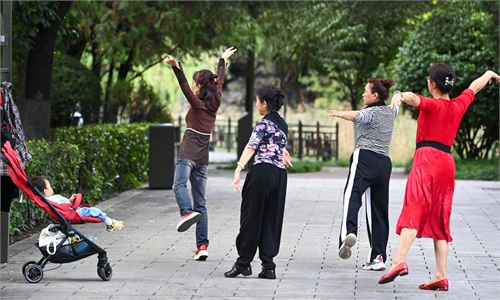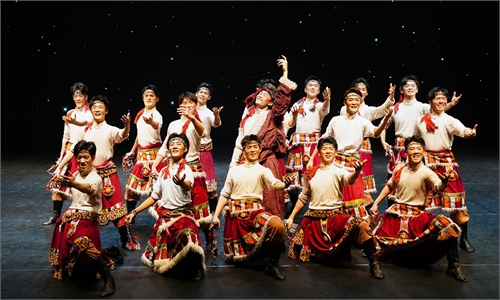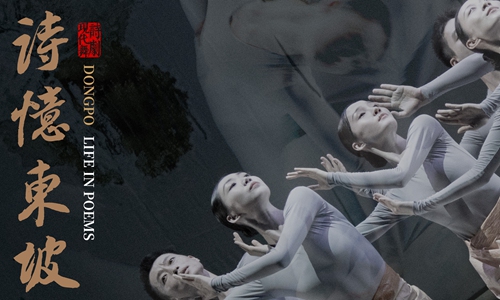ARTS / CULTURE & LEISURE
Why ‘subject three’ dance has swept across world

Illustration: Liu Xiangya
Short clips of the "kemusan" - or "subject three" dance - has become a latest internet sensation on social media platforms at home and abroad. By December 10, the dance, which is widely believed to originate from a wedding dance in South China's Guangxi Zhuang Autonomous Region, had garnered more than 8.88 billion views on short video platforms.
The catchy dance centers on performers showing off some swag dance moves, like swinging their knees sideways as they perform a snappy series of hand actions, including fast wrist-twisting moves, accompanied by music that sounds like a mix of Western disco beats and traditional Chinese folk songs. The dance went viral quickly and has been adapted into various versions - people of all colors and from different walks of life have sprung into the mesmerizing dance.
Why has "subject three" dance become an instant hit? The dance is a kind of "Meipai shake," a freestyle disco dance that swept across the globe in 2014. Nowadays, young people seek to express themselves in personalized and diverse ways. This free and easy swag allows young people to release mental and physical fatigue in routine life and enjoy original delight and pure happiness. Even without personal participation, holding a mobile phone to shoot or watch someone do this dance is enough to connect emotionally and feel a spiritual resonance. "Subject three" dance meets the emotional needs of young people, provides them with an outlet to elicit their feelings and reflects a pleasant sharing of beauty. Its unique perspective and expression blur the boundary between mainstream and non-mainstream aesthetics.
Besides, the recognition and popularity of the dance stem from establishing identity, especially from the young group. When they enjoy and spread this catchy and crazy style, they form a circle in which like-minded people can get together, ignore how others look at them, and have confidence in their taste. To a certain degree, the craze indicates that the main body of social dissemination has changed and involves both consumption trends and the cultural tide. The new generation has a louder voice, more open and diversified vision, higher degree of acceptance and more vital determination in their choices. Their roles have expanded from consumers to producers. A growing number of people have begun to form dance troupes and participate in competitions, which shows that "subject three" can serve as a form of entertainment and a means of constructing youth pop culture.
In addition, the dance belongs to no specific type, and the movements are not set, leaving space for everyone to create their own style. From this perspective, the "subject three" dance is an original work that is close to life, available to ordinary people, open to adaptation, embodies hobbies and interest and bears happiness and sorrow. Despite different cultural backgrounds and languages, there exist similarities in the passion for life and emotional expression of young people from various countries around the world, explaining its global popularity. Unlike the spread of guangchangwu, or the square dance, which prevails mainly in Chinese-speaking areas, "subject three" has set off a round of overseas imitation that shows popular Chinese elements, which signifies a brand-new cross-cultural communication and interactive practice among people.
The dissemination of "subject three" dance has been blessed and empowered thanks to the advancement of short videos. The 52nd Statistical Report on Internet Development in China, released in August by the China Internet Network Information Center, shows that by June, the number of internet users in China had reached 1.079 billion, including 1.026 billion short video users. Short videos are not only a form of online content production but also a way of communication. It has become a vehicle for the development of culture and art with its huge capacity and means of aesthetic expression. A short video can become a catalyst, planter and amplifier for online content production in literature and art. Many vloggers who have shot to fame should give credit to short clips, such as Li Ziqi, who witnessed her followers skyrocket after her short video works were put online. Nowadays, the popularity of "subject three" has also followed a similar route, which uses mass-participation and stars ordinary bloggers. Further, short videos have also stimulated people's enthusiasm for creation, allowing "subject three" to derive more versions and encouraging people to spread it even farther.
All fads or hot trends online will eventually diminish. Still, the discussion on the aesthetic interests of the internet era, youth trends and other topics will move on. The instant sensation of "subject three" around the globe owes a good deal to short video platforms, reflects the diversity of mass culture and serves as an example of China's charm and influence.
The author is a faculty member with the School of Applied Economics, Renmin University of China.






